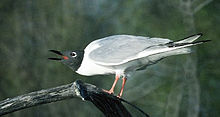- Bonaparte's Gull
-
Bonaparte's Gull 
Adult breeding 
Adult non-breeding Conservation status Scientific classification Kingdom: Animalia Phylum: Chordata Class: Aves Order: Charadriiformes Family: Laridae Genus: Chroicocephalus Species: C. philadelphia Binomial name Chroicocephalus philadelphia
(Ord, 1815)Synonyms Larus philadelphia
The Bonaparte's Gull (Chroicocephalus philadelphia) is a small gull.
The Bonaparte's Gull is a small species, larger only than the Little Gull and the Saunders's Gull among all gull species.[2] Adults are 28–38 cm (11–15 in) long with a 76–84 cm (30–33 in) wingspan and a body mass of 162–270 g (5.7–9.5 oz).[3][4] They have a black hood and a short thin dark bill. The body is mainly white with pale grey back and upper wings. The underwing is pale and the wing tips are dark. They have orange legs. In winter, the head is white.
In their first summer, the appearance of Bonaparte's Gull is similar to that in its first winter, but paler due to wear. Fewer than 5% of Bonaparte's Gulls acquire a dark hood in their first summer, and on those that do, the hood is duller than on breeding adults.
Their breeding habitat is near bogs or lakes in coniferous forest across western Canada and Alaska. They nest in conifers, sometimes on the ground.
They are migratory and most move east or west to coastal waters, also the Great Lakes. They are rare vagrants to western Europe, where they usually associate with the somewhat larger Black-headed Gulls.
These birds forage in flight or pick up objects while swimming or wading. They mainly eat insects, crustaceans and fish. Unlike some other gulls, this bird rarely scavenges.
They are graceful in flight, more like terns. They were named after Prince Charles Lucien Bonaparte, a zoologist and nephew of Napoleon.
Formerly known as Larus philadelphia, the Bonaparte's Gull was moved to the genus Chroicocephalus by the American Ornithologists' Union in July, 2008.
-
Coppermine River, Nunavut
References
- ^ BirdLife International (2004). Larus philadelphia. 2006. IUCN Red List of Threatened Species. IUCN 2006. www.iucnredlist.org. Retrieved on 5 May 2006. Database entry includes justification for why this species is of least concern
- ^ Harrison, Peter, Seabirds: An Identification Guide. Houghton Mifflin Harcourt (1991), ISBN 978-0395602911
- ^ CRC Handbook of Avian Body Masses by John B. Dunning Jr. (Editor). CRC Press (1992), ISBN 978-0849342585.
- ^ [1] (2011).
- Seabirds (Helm Field Guides) 2nd edition, by Peter Harrison, 1991, Christopher Helm Publishers, ISBN 0-7136-3510-X
- "National Geographic" Field Guide to the Birds of North America ISBN 0-7922-6877-6
External links
- Bonaparte's Gull Species Account - Cornell Lab of Ornithology
- Bonaparte's Gull - Larus philadelphia - USGS Patuxent Bird Identification InfoCenter
- Bonaparte's Gull Information and Photos - South Dakota Birds and Birding
- Avibase
Gulls (family: Laridae) Genus Larus Pacific Gull • Belcher's Gull • Olrog's Gull • Black-tailed Gull • Heermann's Gull • Common Gull (or Mew Gull) • Ring-billed Gull • California Gull • Great Black-backed Gull • Kelp Gull (or Cape Gull) • Glaucous-winged Gull • Western Gull • Yellow-footed Gull • Glaucous Gull • Iceland Gull • Kumlien's Gull • Thayer's Gull • European Herring Gull • Heuglin's Gull • American Herring Gull • Yellow-legged Gull • Caspian Gull • Vega Gull (or East Siberian Gull / Mongolian Gull) • Armenian Gull • Slaty-backed Gull • Lesser Black-backed GullIchthyaetus Leucophaeus Chroicocephalus Silver Gull • Red-billed Gull • Huahine Gull • Hartlaub's Gull • Brown-hooded Gull • Grey-headed Gull (or Grey-hooded Gull) • Andean Gull • Black-billed Gull • Brown-headed Gull • Black-Headed Gull • Slender-billed Gull • Bonaparte's GullSaundersilarus Hydrocoloeus Rhodostethia Rissa Pagophila Xema Creagrus Categories:- IUCN Red List least concern species
- Gulls
- Chroicocephalus
Wikimedia Foundation. 2010.



